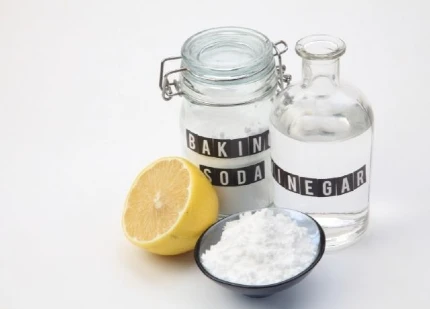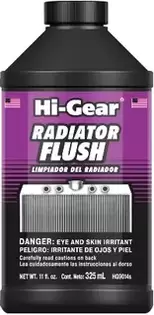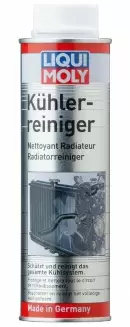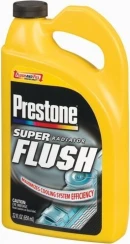
Oil, rust and deposit cleaners for the cooling system
There are both folk remedies for cleaning the cooling system (citric acid, milk whey, «Coca-Cola» and others), and modern technological compositions. To decide which substance to use to clean the radiator and the entire system it is necessary to find out the degree and nature of contamination.
What are the symptoms of a clogged cooling system?
If the engine is heating up a lot — then it's time to pick up the remedy to flush the cooling system.
Depending on the coolant used, rust, oil deposits, antifreeze decomposition products and scale accumulate on the walls of the tubes that make up the radiator. All this leads to the complications of coolant circulation and reduction of heat transfer. And all this affects engine operation, in the form of overheating and increased wear of its individual parts with the risk of their premature failure.
Some cars have a radiator light on the dashboard, the illumination of which may indicate not only that the antifreeze is low, but also that it is time to replace it. It can also be a signal that it is time to clean the cooling system. There are also a number of indirect signs of the necessity of such cleaning:

Dirty radiator
- frequent engine overheating;
- problems in pump operation;
- slow response to rheostat signals (inertia);
- high-temperature readings from the corresponding sensor;
- problems in «heater» operation;
- the fan is always running at high rpm.
Products for flushing the cooling system
There are two types of flushing products — folk and special. For cleaning the cooling system of the car at home use:
For each of the means in the cooling system to work effectively, it is necessary to use both the proportion and the very technology of application.
How to clean the cooling system with citric acid
The most common citric acid, diluted in water, is able to clean the radiator tubes from rust and dirt. It is especially effective if ordinary water is used as a coolant, rather than antifreeze, because acid compositions are effective against rust, and alkaline — against scale. However, remember that a solution of citric acid is not able to remove significant dirt.
How much citric acid do I need?
Dissolve 20-40 grams of the substance in 1 liter of water, and if the dirt is strong, the amount of acid per liter can be increased to 80-100 grams (a larger volume is created in a similar proportion). The ideal is considered when adding acid to distilled water, the pH level is around 3.
How to flush the system with citric acid?
It is necessary to drain all the old liquid and pour a new solution. Next, you need to warm the engine up to operating temperature and leave it for a few hours (or better overnight). Next, drain the solution from the system and look at its condition. If it is very dirty, the procedure should be repeated 1-2 more times until the fluid is clean enough. After that, you must be sure to flush the system with water. Next, pour in the antifreeze that you plan to use as a coolant.

Flushing with acetic acid
The action of this solution is similar to that described above. A solution of acetic acid is excellent for flushing the cooling system of rust.
Will vinegar clean a car radiator?
Acetic acid makes metal susceptible to rust. Therefore, you should strictly adhere to the proportions and not use a concentrated solution, otherwise, you can damage the radiator, and possibly the engine.
How much vinegar does it take to flush a radiator?
When flushing the engine cooling system with vinegar use the following proportion: half a liter of table vinegar per bucket of water (10 liters).
How do you flush with vinegar?
Drain the old liquid, pour the new one and warm the car up to working temperatures. Then you need to leave the car with the engine running for 30-40 minutes so that chemical cleaning can take place in the radiator. Then you need to drain the cleaning fluid and look at its condition. Repeat the procedure until the fluid is clean. Next, you need to flush the system with boiled or distilled water, and then pour the coolant.
How do I flush the cooling system with whey?
Lactic acid or whey is a good tool for cleaning the cooling system, but there are difficulties to get it, and the application requires additional time and amount of water. You will need about 10 liters to flush it.
The way to use whey is as follows:
- strain it 2-3 times through gauze before use to filter out large chunks of fat;
- drain the coolant from the car;
- pour the whey into the cooling system;
- drive about 50-60 kilometers with it;
- it is necessary to merge the serum in a hot condition so that the dirt has not had time to stick to the walls of tubes again (thus to observe a caution!);
- let the engine cool down;
- pour pre-boiled water into the radiator;
- start the engine, warm it up (about 15-20 minutes);
- drain the water;
- pour distilled water;
- start the engine again and let it run for about 10 minutes;
- drain the liquid;
- pour in the antifreeze that you plan to use on a permanent basis.
Can you use baking soda to flush a radiator?
Flushing a radiator with baking soda is rarely used because it is only suitable for removing limescale and oily deposits, and rust or sludge is poorly removed by regular baking soda. After using the sodium bicarbonate solution as a cleaner, you will need to thoroughly flush the system several times with clean distilled water.
How much baking soda is needed to flush the cooling system?
For 10 liters of water use 0.5 kg of baking soda.
How to flush with baking soda?
Pour the solution into the radiator or expansion tank and run the engine. Leave it running until it reaches operating temperature, then leave it to cool, and then you can drain it. The procedure will need to be repeated 2-3 times.
Much more effective will be the use of caustic soda («sodium hydroxide», «caustic alkali», «caustic soda», «caustic»), but it can only be used in copper radiators (must be removed beforehand). In this case, use a 10% solution that should be heated to 90 degrees Celsius. It is undesirable for washing the aluminum radiator (which is used as the main one). Washing the whole cooling system is categorically impossible!
What shouldn't a car radiator be cleaned with?
Despite the fact that the product can remove some sediment, you can not use Coca-Cola soda water. Some motorists in order to wash the cooling system from oil, emulsion, scale, and rust pour cola because it contains a small amount of orthophosphoric acid, able to fight the pollution of the cooling system, but it also has a large amount of sugar and carbon dioxide, which can lead to certain problems.

Using Coca-Cola as a cleaner
Also, if you decide to flush with Coca Cola, be sure to flush the system a couple of times with distilled water, and keep it inside no longer than 10 minutes as orthophosphoric acid can be harmful to plastic, rubber and aluminum parts.
We do not recommend you to use household grease removers like Fairy. A household grease cleaner, which is sometimes tried to remove oil from the cooling system, does not do a good job on engine oil and is difficult to wash out of the system. After using a grease cleaner, in order to wash it out, you will have to pour water in at least 5 times, heat to 90 degrees, drain, and pour distilled water in again!
Never use bleach (sodium hypochlorite) because it corrodes metals, both steel, and aluminum. And the higher the temperature of the liquid and the working surface, the faster the corrosion occurs. Therefore, never pour different stain removers into the system, especially those with chlorine.
Some motorists use a mixture of citric acid (25%), baking soda (50%), and vinegar (25%) for cleaning. However, we do not recommend you to do the same as it is very rough and corrodes rubber and plastic parts. This mixture can be used only if you need to wash the heater radiator and you do not intend to run the liquid through the entire cooling system.
What is the best way to flush the engine cooling system?

Means from the kitchen are cheap, but their effectiveness is inferior to the special fluids, in addition, their application requires more time. Therefore, we recommend that you specifically use a special radiator and cooling system cleaners. The list of the most popular includes 3 effective remedies.
Hi-Gear Radiator Flush. Produced in the U.S. by Hi-Gear. It is sold in the CIS, as well as in Europe and America. Hi-Gear cooling system flush is very popular among car owners around the world. The item number is HG9014s.
325 ml is enough to flush the cooling system up to 17 liters. You can use this product for cleaning the cooling systems of cars and trucks. A distinctive feature is the short operating time, namely 7 minutes.
The useful properties of the product are the fact that it increases the effectiveness of the radiator by 50-70%, eliminates overheating of the cylinder walls, restores the coolant circulation, and decreases the possibility of the engine overheating, protects the pump gland. The product does not contain acids, does not require neutralization, and is not aggressive to plastic and rubber parts.

LIQUI MOLY Kuhler-Reiniger. It is a popular product of the well-known German manufacturer of auto chemicals. It can be used in all cooling and heating systems. It does not contain aggressive alkali and acids. Jar article number for 300 ml. — 1994.
Perfect for car owners who want to wash the engine cooling system from oil, emulsion, and rust. The jar is enough to create 10 liters of cleaning liquid. The remedy is added to the coolant and the engine is left running for 10-30 minutes. After that, the system is cleaned and new antifreeze is poured in.
The cleaner dissolves grease, oil and lime deposits, removes dirt and deposits. The substance is neutral to plastics and rubber and compatible with any coolants. Does not contain corrosive acids and alkali.

Prestone radiator flush. This product is produced in Canada, it is very popular also in the USA and Mexico. It is used in any radiator, the main active ingredient is Sodium Citrate. The jar code is 650 ml. — AS105.
Prestone radiator flush is safe for all cooling systems. It is used to remove sludge and rust.It is used like the two previous products in place of distilled water. For cleaning it is necessary to run the engine to pump the cleaner for 10 minutes or 3 to 6 hours, depending on the type (there are two versions of this cleaner). The disadvantage is its toxicity, so you must wear gloves and a respirator.
FAQ:
-
Will a radiator flush fix a clogged radiator?
Flushing is the only solution to clogging both the radiator and the entire cooling system. It is cleaning all internal parts. Flushing dissolves sediment in clogged pipes or a clogged radiator hose and removes it from the system.
-
Can I flush my radiator myself?
Yes, you can. The easy way: Remove the radiator cap and fill the radiator with distilled water until it is full. Screw the cap on, then start the engine and let it run for 15 minutes. The distilled water will wash away debris, corrosion, and old coolant.
-
How do you make a homemade radiator flush?
The most popular method is to mix baking soda with water. Put 5 teaspoons of baking soda in 1 liter of water. Add the solution to the cooling system and warm up the engine. Drain the solution from the system and then flush it again with distilled water.